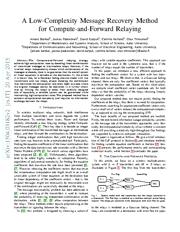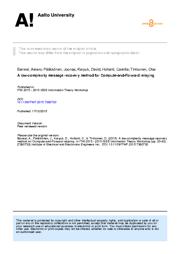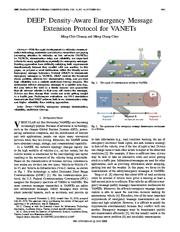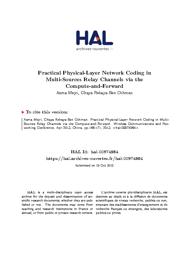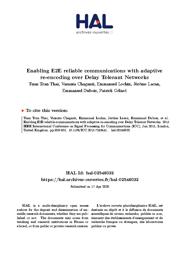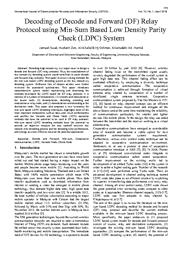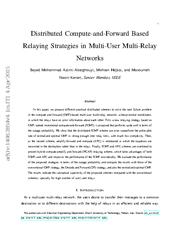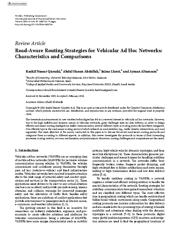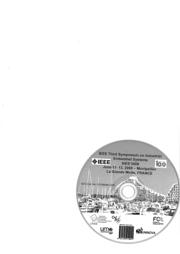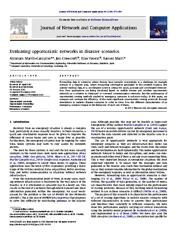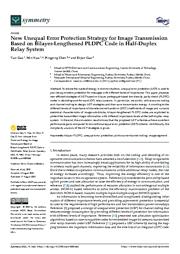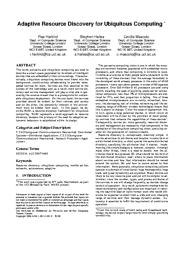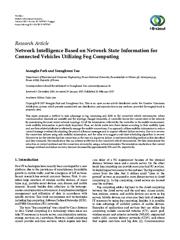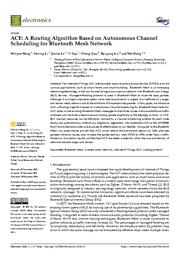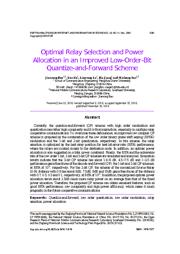A copy of this work was available on the public web and has been preserved in the Wayback Machine. The capture dates from 2020; you can also visit the original URL.
The file type is application/pdf.
Filters
A Low-Complexity Message Recovery Method for Compute-and-Forward Relaying
[article]
2015
arXiv
pre-print
The proposed method has a constant computational complexity and requires no information exchange between the relays. ...
The Compute-and-Forward relaying strategy achieves high computation rates by decoding linear combinations of transmitted messages at intermediate relays. ...
ACKNOWLEDGEMENTS The authors are financially supported by the Academy of Finland grants #276031, #282938, #283262 and #268364, the Finnish Funding Agency for Innovation grant 40142/13, and a grant from ...
arXiv:1504.03182v2
fatcat:eg54lsmzkzafbcasp2ytucccuy
A low-complexity message recovery method for Compute-and-Forward relaying
2015
2015 IEEE Information Theory Workshop - Fall (ITW)
The proposed method has a constant computational complexity and requires no information exchange between the relays. ...
The Compute-and-Forward relaying strategy achieves high computation rates by decoding linear combinations of transmitted messages at intermediate relays. ...
ACKNOWLEDGEMENTS The authors are financially supported by the Academy of Finland grants #276031, #282938, #283262 and #268364, the Finnish Funding Agency for Innovation grant 40142/13, and a grant from ...
doi:10.1109/itwf.2015.7360730
dblp:conf/itw/BarrealPKHT15
fatcat:qxudvp7spbcqvdjo7gzadkpug4
DEEP: Density-Aware Emergency Message Extension Protocol for VANETs
2013
IEEE Transactions on Wireless Communications
In VANETs, dissemination delay and reliability are important criteria for many applications, especially for emergency messages. ...
DEEP resolves the broadcast storm problem, achieves low dissemination delay, and provides high reliability over a realistic multi-lane freeway scenario. ...
Fast Forwarding Mechanism In this work, the methods for segmenting blocks include a regular segmentation method and an irregular segmentation method. ...
doi:10.1109/twc.2013.090413.121697
fatcat:lhpvbjyjsrdajpdso3yrjpslgu
Practical Physical Layer Network Coding in Multi-Sources Relay Channels via the Compute-and-Forward
2013
2013 IEEE Wireless Communications and Networking Conference Workshops (WCNCW)
Recent years have witnessed the development of the Compute-and-Forward (CF) as a successful solution to perform noiseless linear Physical Layer Network Coding (PLNC). ...
What misses is to design practical PLNC schemes based on the Compute-and-Forward and to evaluate their end-to-end performance in real communication scenarios. ...
ACKNOWLEDGMENTS The authors would like to acknowledge the European Commission for funding SmartEN ITN (Grant No. 238726) under the Marie Curie ITN FP7 program. ...
doi:10.1109/wcncw.2013.6533334
dblp:conf/wcnc/MejriO13
fatcat:6hqkq4ssnne4fgq23mrygdbiiu
Enabling E2E reliable communications with adaptive re-encoding over Delay Tolerant Networks
2015
2015 IEEE International Conference on Communications (ICC)
Finally, we propose an adaptive mechanism with low complexity that deals with both rerouting events and network dynamics which are common in the context of DTN. ...
Simulation results show that re-encoding at the relay and the adaptive mechanism allows a significant reduction in terms of network overhead injected by erasure codes while ensuring the E2E reliability ...
The intermediate node, which could be a satellite, usually has limited computational power, and is constrained to only be able to forward or re-encode received bundles, and cannot choose to decode. ...
doi:10.1109/icc.2015.7248441
dblp:conf/icc/ThaiCLL0G15
fatcat:ydzngjazqvh23kdxviukewjpzu
Decoding of Decode and Forward (DF) Relay Protocol using Min-Sum Based Low Density Parity Check (LDPC) System
2018
International Journal of Communication Networks and Information Security
Decoding high complexity is a major issue to design a decode and forward (DF) relay protocol. ...
Thus, the establishment of low complexity decoding system would beneficial to assist decode and forward relay protocol. ...
Relay node performs two main kinds of message forwarding strategy which can be group as regenerative and non-regenerative which depend on applied signal processing method. ...
dblp:journals/ijcnis/SuudZOH18
fatcat:pfyuflfsbvedrda5po3ith3pim
Distributed Compute-and-Forward Based Relaying Strategies in Multi-User Multi-Relay Networks
[article]
2015
arXiv
pre-print
First, a new relaying strategy based on CMF, named incremental compute-and-forward (ICMF), is proposed that performs quite well in terms of the outage probability. ...
Finally, ICMF and AFC schemes are combined to present hybrid compute-amplify and forward (HCAF) relaying scheme, which takes advantages of both ICMF, and AFC and improves the performance of the ICMF considerably ...
Compute and Forward, M=3
Hybrid Compute−Amplify and Forward, M=3
Note that an equation with message transmission power of P and effective recovery noise variance of Neq has computation rate equal ...
arXiv:1408.2854v4
fatcat:si63pu7iobawtmhymc6bzqk7mq
Road-Aware Routing Strategies for Vehicular Ad Hoc Networks: Characteristics and Comparisons
2016
International Journal of Distributed Sensor Networks
In addition, this review investigates the protocols in terms of their forwarding processes, routing metrics, recovery mechanisms, and performance. ...
However, due to the high mobility and dynamic nature of vehicular networks, great challenges exist for data delivery. ...
Acknowledgments The authors would like to extend their sincere appreciation to the Deanship of Scientific Research at King Saud University for funding this research. ...
doi:10.1155/2016/1605734
fatcat:u4mfwgocxvhonmbrt3x7hjlwwa
TPR: Dead end aware table less position based routing scheme for low power data-centric wireless sensor networks
2008
2008 International Symposium on Industrial Embedded Systems
It also deals with dead end problems by a recovery strategy in a distributed and localized way. ...
In this paper we present a Table less Position based Routing (TPR) scheme for low power data centric wireless sensor networks. ...
New routing techniques which are energy efficient, memory efficient, and less computational complex are required. ...
doi:10.1109/sies.2008.4577693
dblp:conf/sies/MadaniWM08
fatcat:ht3gqizwgbhdpdshku46agyf3y
Evaluating opportunistic networks in disaster scenarios
2013
Journal of Network and Computer Applications
An example scenario is a disaster area, where forwarding information generated in the incident location, like victims' medical data, to a coordination point is critical for quick, accurate and coordinated ...
Forwarding data in scenarios where devices have sporadic connectivity is a challenge. ...
Catalan DURSI Grant 2009SGR1224 and by EU RECOGNITION project (FP7-ICT 257756). ...
doi:10.1016/j.jnca.2012.11.001
fatcat:uc53rawigvhltigwlgqtmo5o4y
New Unequal Error Protection Strategy for Image Transmission Based on Bilayer-Lengthened PLDPC Code in Half-Duplex Relay System
2022
Symmetry
This paper proposes new efficient strategies of UEP based on bilayer protograph-based low-density parity check (PLDPC) codes in decoding-and-forward (DF) relay systems. ...
To reduce the waste of energy in communications, unequal error protection (UEP) is used to provide asymmetric protection for messages with different levels of importance. ...
that the relay completely decodes the transmitted message from the source and partially forwards the decoded message to the destination. ...
doi:10.3390/sym14081662
fatcat:spc5lnfk2zch5asi6bapinjxru
Adaptive resource discovery for ubiquitous computing
2004
Proceedings of the 2nd workshop on Middleware for pervasive and ad-hoc computing -
In this paper, we describe RUBI, a resource discovery framework for ubiquitous computing. ...
The terms pervasive and ubiquitous computing are used to describe a smart space populated by hundreds of intelligent devices that are embedded in their surroundings. ...
RUBI has no special recovery procedure for resources that go offline and return a short while later and in this case, resource owners will register resources with relays in the usual way if a proactive ...
doi:10.1145/1028509.1028519
dblp:conf/middleware/HarbirdHM04
fatcat:4oe3v67nlrhqdc4j7vfm5du5rm
Network Intelligence Based on Network State Information for Connected Vehicles Utilizing Fog Computing
2017
Mobile Information Systems
This paper proposes a method to take advantage of fog computing and SDN in the connected vehicle environment, where communication channels are unstable and the topology changes frequently. ...
Our approach utilizes mobility information to reduce control message overhead by adjusting the period of beacon messages and to support efficient failure recovery. ...
For example, rapidly moving cars are preferred for relaying data to a distant location, while slowly moving cars, passing through a congested area, are favorable as localized computational resources. ...
doi:10.1155/2017/7479267
fatcat:5goslgkybzevjb6nhekpml4gxm
ACE: A Routing Algorithm Based on Autonomous Channel Scheduling for Bluetooth Mesh Network
2021
Electronics
ACE relies on the existing Bluetooth Mesh messages to distribute routes without additional traffic overhead and conducts a beacon-aware routing update adaptively as the topology evolves. ...
In ACE, BLE channel resources can be efficiently utilized by a channel scheduling scheme for each node locally and autonomously without any neighborly negotiation. ...
The relay node 1 and the relay node 2 in the middle are responsible for forwarding the message from the source node to the destination node. ...
doi:10.3390/electronics11010113
fatcat:x4pnq5buhfdm3oa5jheknhzrte
Optimal Relay Selection and Power Allocation in an Improved Low-Order-Bit Quantize-and-Forward Scheme
2016
KSII Transactions on Internet and Information Systems
Currently, the quantize-and-forward (QF) scheme with high order modulation and quantization has rather high complexity and it is thus impractical, especially in multiple relay cooperative communications ...
To overcome these deficiencies, an improved low complex QF scheme is proposed by the combination of the low order binary phase shift keying (BPSK) modulation and the 1-bit and 2-bit quantization, respectively ...
The improved Quantize-and-Forward Scheme According to the relay system model in Fig. 1 and the related analyses, an improved low complex QF scheme is proposed as follows. ...
doi:10.3837/tiis.2016.11.010
fatcat:wwvfqyonvzdhnkldjcdimvq3yi
« Previous
Showing results 1 — 15 out of 9,179 results

